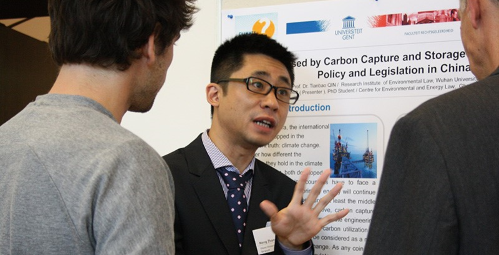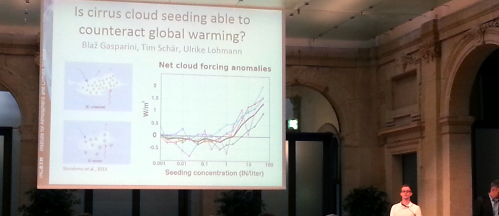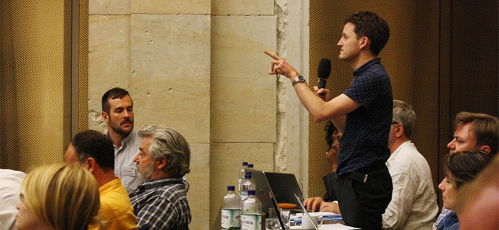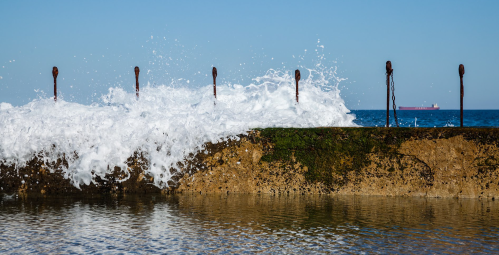Day 2 - Can we find out what we don't know about CE? And once we find out, who has the right and the means to make the big decisions?
(comments: 0)

Day 2: Wednesday, July 8 2015
The second day of the symposium included two separate sessions with seven presentations each. The first session of the day, entitled "Climate Engineering Uncertainties" aimed to help us understand exactly where the blind spots in our scientific and technical knowledge of CE lie, and to explore whether these uncertainties can be reduced.
The session kicked off with a keynote speech by Ulrike Lohmann, who highlighted the many unknowns associated with the interaction between aerosols and cirrus clouds and pointed out that many optimistic marine cloud brightening (MCB) simulations could be simply an artifact of the coarse resolution of the models used. She underlined that model intercomparisons or multi-model-ensembles such as GeoMIP are key to estimating MCB model uncertainty. Gregor Betz followed with a brief commentary asking us to question whether we can even be certain about what uncertainty is. He questioned that multi-model-ensembles will help us estimate model uncertainty, suggesting that they can rather only give us a lower bound on the maximum range of uncertainty. So comparing models may not help us to find out exactly what we don't know, but perhaps they can help us understand how little we know.
This theme was continued by David Keller, who raised the question as to how much we should trust simulated CE models. The fact that we have incomplete knowledge of how the back ground climate modeled works, and that the stylized CE technologies introduced into that background climate simulation do not yet exist combine to compound the inherent uncertainty of models. David's take-home message for us was that model parameter variability makes it very difficult to distinguish effects of most CE scenarios in models, and he thus emphasized the need for better perturbed parameter studies in the future.
Ulrike Niemeier followed with a presentation inquiring whether it is possible to establish the theoretical limit to the amount of sulfate which can be injected into the stratosphere. Her modeling work indicates that with long-term sulfate injection, cooling efficiency decreases due to the resulting increase in particle size and decreased scattering, meaning: The more we inject, the less the effect. In the same vein as the prior presenters Ulrike noted the difficulty in comparing her modeling results with that of others, as the parameters used are often different, making results largely model dependent.

In a change of pace from natural to social science, Andy Parker went on to explore the concept of the "termination shock" in the fourth talk of the day. The term "termination shock" refers to the sudden spike in temperatures that would be expected to occur if long-term SRM measures were suddenly ceased. As Andy pointed out, although the idea of what could potentially happen if SRM was suddenly halted have frequently been presented as prominent argument against deployment, so far there has been little investigation into exactly why such a sudden cessation might come to pass . Andy's presentation aimed to outline a conceptual toolbox to structure the discussion on the issue of termination shock. Central concepts to understanding termination shock include; the critical forcing threshold before which it would be safe to turn off SRM without significant negative side effects; a ramp-up and ramp-down period when SRM is introduced and/or creased gradually rather than suddenly; and a "buffer period" during which SRM, even if it had been temporarily ceased without warning, could be reinitiated before the climate system starts to react. He further differentiated between forced and elective termination. He defined the former as any situation in which SRM termination is forced upon humanity and listed some situations which could qualify: A terrorist attack might result in termination shock, but only if 1) defenses don't hold, 2) there is no SRM deployment back-up plan and 3) no-one else is capable of deployment. However, Andy Parker surmised that this would be quite unlikely as SRM is fungible. A catastrophe might also lead to termination shock, but only if it was global rather than regional (e.g. pandemic, nuclear war, asteroid strike). In comparison elective termination in which one of more parties have the will and the power to enforce the halt SRM, there are not acceptable alternatives and no ramping down is attempted could lead to termination shock. However, Andy suggested that as the termination of SRM would be almost impossible to enforce unilaterally, elective termination seems unlikely to lead to termination shock. He went on to emphasize the necessity of evaluating the implications of these considerations in light of intergenerational justice and the likelihood of lock-in.
Shifting the focus back to natural science, Miriam Ferrer-Gonzales followed with a discussion of the scope and side-effects of large-scale ocean alkalinity enhancement. Her modeling indicated that that there would be regional variations in resulting changes in surface atmospheric temperatures, with more cooling in the arctic and over land than over sea. While the effects of ocean acidification were mitigated in her model, ocean pH and omega rose above pre-industrial levels, and there was also an indication of an increase in heavy mental traces. The audience raised questions about the effects of these changes on ocean biodiversity, which remain largely unknown.

Johannes Lenhard then led us through a thought experiment on developing a more suitable categorization of uncertainty with regard to CE. He emphasized that choosing the right level of abstraction such a typology is imperative: where as a simple risk vs. uncertainty dichotomy would be too unspecific, an overly fine grained typology would not lead to complexity reduction and increased understanding of the unknowns associated with CE. He went on to suggest a four-type categorization ranging from "Deep ignorance", over "Ignorance" and "Uncertainty" to "Risk." The second part of Johannes' talk asked what CE modeling simulations can achieve in terms of (un)certainty, indicating that with growing model complexity, it becomes increasingly unclear what role particular parameterization schemes or parameter values play and that coupling different models aggravates the problem.
Continuing with the theme of how to understand and perceive concepts, Matthias Honegger presented a proposal for a project to test how knowledge about SRM could influence individuals' willingness to support mitigation. His working hypothesis, based on assumptions of cultural cognition theory, is that if information on CE is compatible with a person's values, their willingness to pay for mitigation is reduced, and vice versa. His project aims to test this hypothesis by identifying the cultural values of groups of interview participants and then eliciting their willingness to pay for mitigation pre-/post information about CE.
The day's second session which followed after lunch focused on questions of CE governance. The seven presentations in the afternoon centered around different aspects of the question: Even if the uncertainties indentified in the morning's session could be reduced and fully informed decisions could be made on CE research, development and deployment, who would/could/should make these decisions?
In the first presentation after lunch, Joshua Horton looked at mini-lateralism as a comprehensive SRM governance option. He defined mini-lateral groups, clubs or exclusive coalitions as an institutionalized cooperation among a subset of states and presented results applying game theory to the formation and implementation of international environmental agreements that indicated such exclusive membership coalitions result in stable governance structures. This is assumed to be because exclusivity allows states with similar costs/benefits (interests) to keep others out, reducing conflict potential. Additionally, since similar states get comparable benefits (from cooperation) at comparable costs within the exclusive coalition, there is a strong incentive to keep cooperating. Joshua then went on to discuss how a mini-lateral "Climate Club" to govern CE could link SRM to mitigation by making participation in SRM decision-making conditional on a state's efforts on mitigation, thereby countering moral hazard and facilitating bargaining. Discussing the problematic legitimacy of such an exclusive CE governance group, Joshua pointed to several exclusive international "clubs" that are often considerate legitimate, including the WTO, G7, G20 and NATO, but indicated that many questions remain to be answered regarding both the procedural and output legitimacy of such a "Climate Club."
The next presentation by Daniel Heyen shifted the focus away from the governance of deployment and onto the potential conflicts involved in the governance of CE research and development (R&D). Based on a simple game-theoretical model which included free-riders and free drivers, Daniel asked, "If countries anticipate the outcomes in the deployment game: How will this affect whether they want to engage in R&D?" Based on the assumption that players in the CE "game" would have an incentive to invest in R&D in light of potential benefits and strategic conflicts associated with deployment in the future, Daniel concluded that if the sum of R&D contributions exceed a certain (commonly known) threshold, then the CE technologies would be available to both countries, otherwise to none.
Jesse Reynolds' introduced the audience to the idea of a research commons for SRM to deal with the governance challenge in the medium term. He suggested that as state action on SRM governance is unlikely in the near future because SRM is controversial and cuts against the well-established climate discourse, private law may be able to act as a bridge between short term self-regulation and long-term tans-national governance proposals. With this in mind, he suggested that researcher and institutions would commit to contribute their output into a research commons. In return for compliance with agreed upon research standards, those committed to the research commons would be given free access the output generated by committed actors. The research commons would make methods and research designs available ex ante, and ensure the availability of all data in a standardized, centralized, a central, public directory of all CE research results and publications. Jesse additionally suggested that this commons could also include a patent pool. Although many are opposed to the idea of patenting SRM technologies, Jesse emphasized that simply foregoing filing patents does not prevent others from doing so. As members of his suggested patent pool, committed researchers would contractually agree to freely license any patents from their research to other researches legitimate SRM research which complies with agreed upon research standards, including prior impact assessment, public notification, engagement, participation, cooperation with regulators, independent assessment of results, best practices for research, due diligence etc. Compliant members of the pool would thus be free to share their patents among themselves, but could only earn royalties outside the pool for non-CE applications of the technologies developed. Jesse indicated that presently the best bodies to take this on would be existing national and international scientific bodies, but there is a need to develop additional capacity towards integrating IGOs, NGOs etc and he envisages the private law framework developing an increasingly public nature over time.

Emphasizing that action on CE does not involve a single decision, but a dynamic chain of interrelated decisions, Weili Weng presented her work with a computer-based Dynamic Decision-Making model. The model incorporates contextual elements and dynamic, flexible interactive stakeholders to simulate the complex web of the CE decision-making process. She concluded by pointing out that the use of these type of tools can only be used to gain insight into complex decision-making processes, not as a basis for CE decision-making in the real world.
The Brian Citro and Patrick Smith picked up on the discussion on the appropriateness of relying on cost benefit analysis to assess CE technologies. Based on the assumption that it is unlikely that all human interests are captured in utilitarian cost benefit analyses, their presentation looked at developing an alternative CE assessment and decision-making framework based on human rights. They looked at identifying the need for constructivist deliberative way to evaluate rights claims in a way that would ideally practice oriented. As a multitude of individuals and groups make claims based on human rights arguments, they suggested a focus on especially vulnerable or marginalized groups and the prioritization of the principle of non-discrimination when establishing the framework.
Wilfried Rickels followed with a presentation on how uncertainty and incentives could play a role in the development of a SRM compensation scheme. As the variability of the climate system prevents deriving a clear causal link between observed climate and the level of SRM deployment, he suggested an upper or lower threshold on climate variation might be appropriate when deciding when compensation is required. These thresholds would have to be negotiated and agreed upon by the participating parties. The type of compensation scheme Wilfried proposed would theoretically implement the social optimal solution and aims to ensure that the climate engineer has full responsibility for the climate.

In the final talk before the dinner break, David Morrow delved deeper into our understanding of the slippery slope argument against CE research and development. The basic slippery slope argument is as follows: If some kinds of CE research are done, they will lead to deployment, which would a bad outcome, therefore these types of research should not be done. David asked: How exactly will research lead to deployment? He identified five mechanisms which are often implied by those using the slippery slope argument: 1) Vested interests - Academics, bureaucrats and commercial entities invest time, energy and money into research and development and then push for deployment; 2) Jamieson's cultural imperative, which says if you build it, someone will come and use it; 3) Legitimization or normalization of an idea through research could lead to acceptance of its implementation; 4) Moral hazard necessitates deployment - we stop mitigating, and thus are forced to resort to CE; 5) Increasing inability to constrain rogue deployment. If ongoing research lowers the cost of CE technologies, the more players there are who could do it. So be engaging in further research, you increase the number of people who could do it. David then presented some ideas for how we could "throw sand on the slippery slope" by stopping research, structuring our careers so that we are not solely dependent on ongoing CE research, combating misinformation about CE in public discourse, minimizing intellectual property ownership in making deployment profitable, creating governance institutions that make deployment decisions more globally democratic, and by slowing down decision-making process to stop someone being able to suddenly push a panic button.
After dinner we were treated to a very different kind of presentation on CE. Josh Wodack did not present any results or research projects, but rather art projects that illustrated different views on feelings, images, hopes, and fears about environmental alternation. Under the titled “Art that Sucks” a Dutch artist proposed a giant vacuum cleaner that sucks smog from Beijing air. Other artistic displays dealt with technical fixes or their outcomes. In Josh’s installations Shape Things to Come he explores “how humans may shape things to come through climate engineering interventions designed to separate existing life forms from six degrees of catastrophe”. Installations, videos and other forms of art aim to create new ideas or at least make more levels of CE visible. When asked if art could also promote undesirable ideas, Josh replied that it could in theory, but in particular it offered a way to encourage people to become involved and begin thinking about crucial issues like climate change.


Add a comment